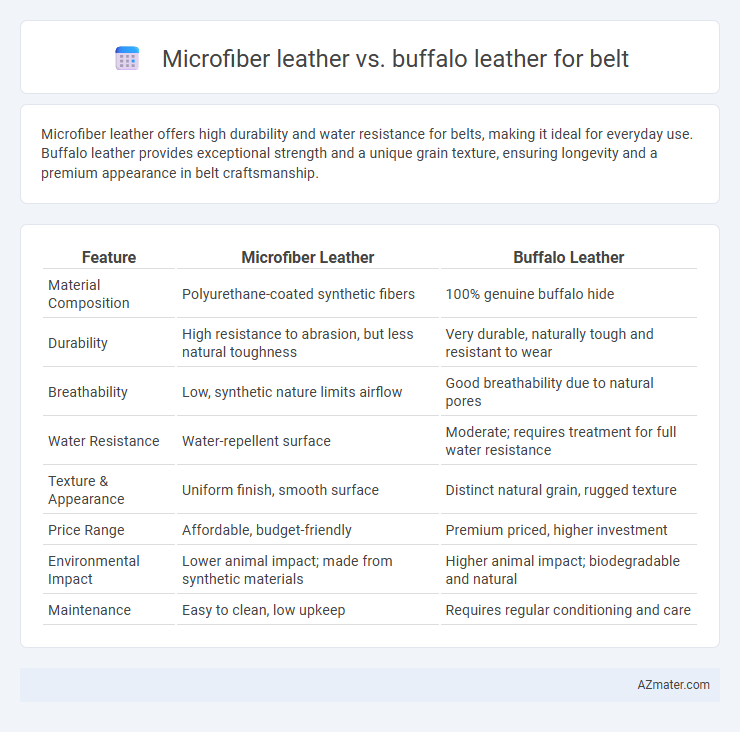Microfiber leather offers high durability and water resistance for belts, making it ideal for everyday use. Buffalo leather provides exceptional strength and a unique grain texture, ensuring longevity and a premium appearance in belt craftsmanship.
Table of Comparison
| Feature | Microfiber Leather | Buffalo Leather |
|---|---|---|
| Material Composition | Polyurethane-coated synthetic fibers | 100% genuine buffalo hide |
| Durability | High resistance to abrasion, but less natural toughness | Very durable, naturally tough and resistant to wear |
| Breathability | Low, synthetic nature limits airflow | Good breathability due to natural pores |
| Water Resistance | Water-repellent surface | Moderate; requires treatment for full water resistance |
| Texture & Appearance | Uniform finish, smooth surface | Distinct natural grain, rugged texture |
| Price Range | Affordable, budget-friendly | Premium priced, higher investment |
| Environmental Impact | Lower animal impact; made from synthetic materials | Higher animal impact; biodegradable and natural |
| Maintenance | Easy to clean, low upkeep | Requires regular conditioning and care |
Introduction to Microfiber Leather and Buffalo Leather
Microfiber leather is a synthetic material composed of ultra-fine fibers, designed to mimic the texture and durability of natural leather while offering enhanced water resistance and breathability. Buffalo leather, derived from the hide of water buffalo, is known for its robustness, natural grain, and rich texture, providing excellent durability and a luxurious appearance for belts. Both materials present distinct advantages in belt manufacturing, with microfiber leather excelling in sustainability and ease of maintenance, while buffalo leather emphasizes traditional strength and authenticity.
Material Composition and Manufacturing Process
Microfiber leather consists of a polyurethane (PU) coating applied over a microfiber base, engineered to mimic the texture and durability of natural leather through a synthetic, non-animal-based composition. Buffalo leather, derived from the hides of water buffalo, undergoes traditional tanning processes involving crude oils or vegetable tannins, enhancing its dense fibrous structure for increased toughness and water resistance. The manufacturing of microfiber leather emphasizes precision layering and chemical treatments for consistent quality, whereas buffalo leather relies on natural grain patterns and skilled craftsmanship for its distinct rugged aesthetic.
Durability Comparison: Microfiber vs Buffalo Leather
Microfiber leather offers excellent resistance to scratches and water, making it highly durable for everyday belt use, while buffalo leather is known for its natural toughness, strength, and ability to develop a rich patina over time. Buffalo leather belts often outperform microfiber in terms of longevity and resilience against wear and tear due to their dense fiber structure. Choosing between microfiber and buffalo leather for belts depends on the balance between synthetic durability and the authentic aging characteristics of natural leather.
Appearance and Texture Differences
Microfiber leather offers a smooth, consistent surface with a fine grain pattern that mimics genuine leather, providing a sleek and polished appearance ideal for modern belt designs. Buffalo leather exhibits a more pronounced, rugged texture with natural grain variations and larger pores, giving belts a distinctive, rustic look and a sturdy, tactile feel. While microfiber leather tends to be softer and more uniform, buffalo leather delivers a robust, coarse texture that ages uniquely with wear.
Comfort and Flexibility in Belt Usage
Microfiber leather offers superior comfort and flexibility in belt usage due to its lightweight, breathable structure and soft texture, reducing skin irritation during extended wear. Buffalo leather, while durable and sturdy, tends to be thicker and less flexible initially, requiring a break-in period to achieve comparable comfort. For daily use, microfiber leather belts adapt more quickly to body movements, enhancing overall wearability and ease of adjustment.
Environmental Impact and Sustainability Factors
Microfiber leather offers a lower environmental impact compared to buffalo leather due to its synthetic composition, which reduces reliance on animal agriculture and deforestation. Buffalo leather, sourced from water buffalo hides, involves significant resource consumption, including water, land, and chemicals used in tanning processes that contribute to pollution. Sustainable belt production favors microfiber leather for its potential to minimize carbon footprint and waste, especially when crafted from recycled or eco-friendly materials.
Price and Cost-Effectiveness
Microfiber leather belts are significantly more affordable than buffalo leather belts, making them an attractive option for budget-conscious consumers seeking durable accessories. Buffalo leather belts offer superior longevity and natural texture, which justifies their higher price through extended use and enhanced aesthetic appeal. Choosing microfiber leather maximizes cost-effectiveness for frequent replacement needs, while buffalo leather ranks higher for long-term investment and premium quality.
Maintenance and Care Requirements
Microfiber leather belts require minimal maintenance, as they are resistant to stains, water, and fading, and can be easily cleaned with a damp cloth without the need for conditioning. Buffalo leather belts demand regular care, including periodic cleaning with saddle soap and conditioning with leather oils to prevent drying and cracking, ensuring longevity and maintaining suppleness. Both materials benefit from avoiding prolonged exposure to moisture and direct sunlight to preserve quality, but microfiber leather offers a more convenient and low-maintenance option.
Applications and Style Versatility
Microfiber leather offers exceptional durability and water resistance, making it ideal for casual and active wear belts that require low maintenance and a lightweight feel. Buffalo leather, known for its rugged texture and natural grain, suits premium, vintage, and formal belt styles demanding a classic, robust appearance with long-lasting aging. Both materials provide style versatility; microfiber leather aligns with contemporary, minimalist designs while buffalo leather complements traditional, rustic, and luxury fashion trends.
Conclusion: Which Leather is Better for Belts?
Microfiber leather offers superior water resistance, lightweight durability, and eco-friendly qualities ideal for belts used in active or wet environments. Buffalo leather provides exceptional strength, natural grain texture, and long-lasting wear, making it suitable for classic, heavy-duty belt designs. Choosing between microfiber and buffalo leather depends on whether you prioritize sustainability and moisture resistance or traditional ruggedness and natural aging.

Infographic: Microfiber leather vs Buffalo leather for Belt
 azmater.com
azmater.com